Curtin University Essay: Social Media Influence on Children
VerifiedAdded on 2022/08/26
|7
|2105
|27
Essay
AI Summary
This essay delves into the multifaceted influence of social media on children, focusing primarily on its negative impacts. It examines how platforms like Facebook, Instagram, and Twitter affect children's mental health, leading to anxiety, depression, and body image issues due to the constant pursuit of online validation. The essay highlights the displacement of real-time interactions and the rise of cyberbullying as significant concerns, citing real-world examples and statistical data to support these arguments. Conversely, the essay acknowledges the positive aspects, such as increased knowledge and enhanced awareness of current events, as well as the potential for social skill development. Ultimately, the essay concludes that social media, despite its benefits, poses a distressing impact on the well-being of children, particularly in terms of mental health, cyberbullying, and the erosion of real-world relationships.
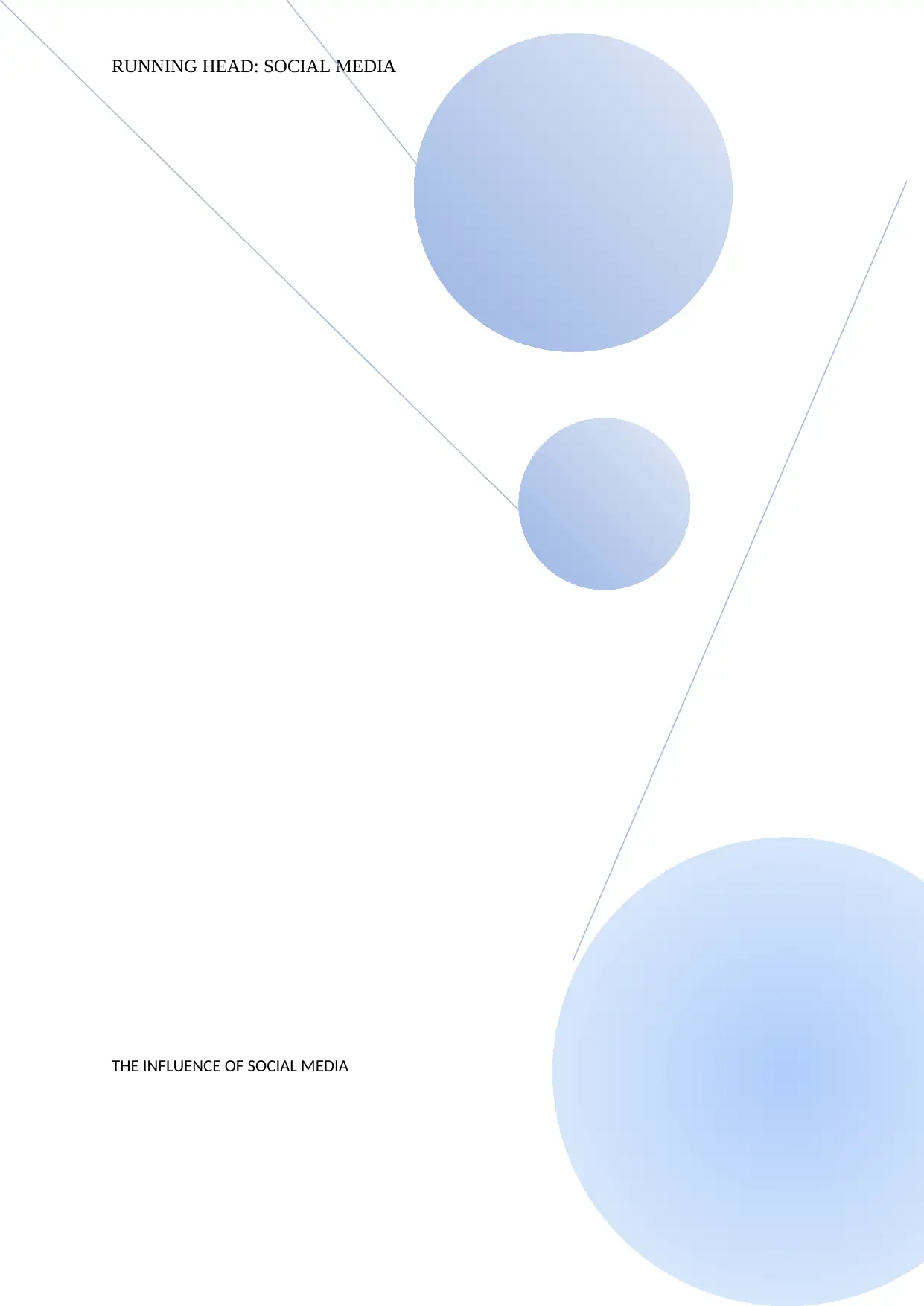
RUNNING HEAD: SOCIAL MEDIA
THE INFLUENCE OF SOCIAL MEDIA
THE INFLUENCE OF SOCIAL MEDIA
Paraphrase This Document
Need a fresh take? Get an instant paraphrase of this document with our AI Paraphraser
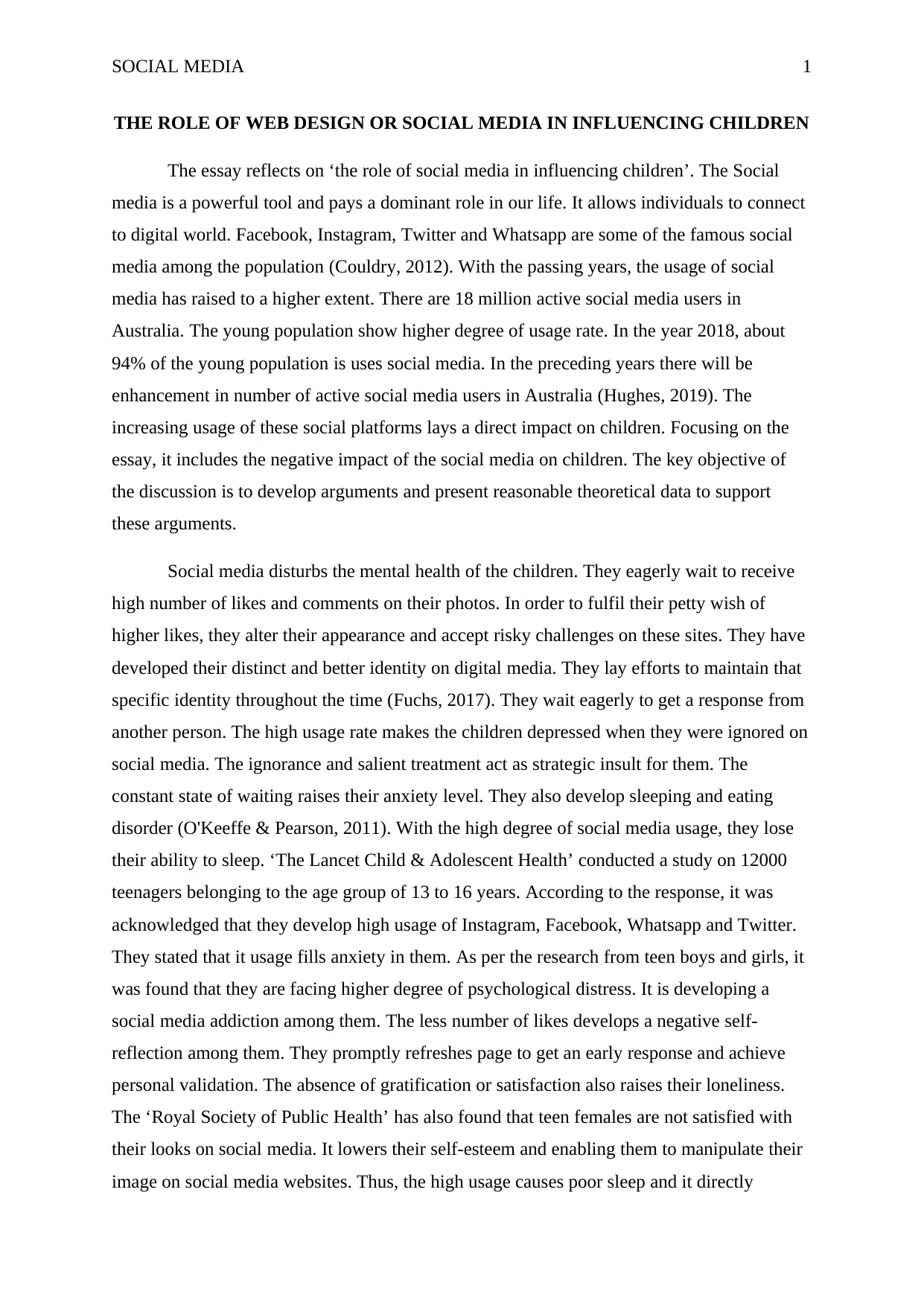
SOCIAL MEDIA 1
THE ROLE OF WEB DESIGN OR SOCIAL MEDIA IN INFLUENCING CHILDREN
The essay reflects on ‘the role of social media in influencing children’. The Social
media is a powerful tool and pays a dominant role in our life. It allows individuals to connect
to digital world. Facebook, Instagram, Twitter and Whatsapp are some of the famous social
media among the population (Couldry, 2012). With the passing years, the usage of social
media has raised to a higher extent. There are 18 million active social media users in
Australia. The young population show higher degree of usage rate. In the year 2018, about
94% of the young population is uses social media. In the preceding years there will be
enhancement in number of active social media users in Australia (Hughes, 2019). The
increasing usage of these social platforms lays a direct impact on children. Focusing on the
essay, it includes the negative impact of the social media on children. The key objective of
the discussion is to develop arguments and present reasonable theoretical data to support
these arguments.
Social media disturbs the mental health of the children. They eagerly wait to receive
high number of likes and comments on their photos. In order to fulfil their petty wish of
higher likes, they alter their appearance and accept risky challenges on these sites. They have
developed their distinct and better identity on digital media. They lay efforts to maintain that
specific identity throughout the time (Fuchs, 2017). They wait eagerly to get a response from
another person. The high usage rate makes the children depressed when they were ignored on
social media. The ignorance and salient treatment act as strategic insult for them. The
constant state of waiting raises their anxiety level. They also develop sleeping and eating
disorder (O'Keeffe & Pearson, 2011). With the high degree of social media usage, they lose
their ability to sleep. ‘The Lancet Child & Adolescent Health’ conducted a study on 12000
teenagers belonging to the age group of 13 to 16 years. According to the response, it was
acknowledged that they develop high usage of Instagram, Facebook, Whatsapp and Twitter.
They stated that it usage fills anxiety in them. As per the research from teen boys and girls, it
was found that they are facing higher degree of psychological distress. It is developing a
social media addiction among them. The less number of likes develops a negative self-
reflection among them. They promptly refreshes page to get an early response and achieve
personal validation. The absence of gratification or satisfaction also raises their loneliness.
The ‘Royal Society of Public Health’ has also found that teen females are not satisfied with
their looks on social media. It lowers their self-esteem and enabling them to manipulate their
image on social media websites. Thus, the high usage causes poor sleep and it directly
THE ROLE OF WEB DESIGN OR SOCIAL MEDIA IN INFLUENCING CHILDREN
The essay reflects on ‘the role of social media in influencing children’. The Social
media is a powerful tool and pays a dominant role in our life. It allows individuals to connect
to digital world. Facebook, Instagram, Twitter and Whatsapp are some of the famous social
media among the population (Couldry, 2012). With the passing years, the usage of social
media has raised to a higher extent. There are 18 million active social media users in
Australia. The young population show higher degree of usage rate. In the year 2018, about
94% of the young population is uses social media. In the preceding years there will be
enhancement in number of active social media users in Australia (Hughes, 2019). The
increasing usage of these social platforms lays a direct impact on children. Focusing on the
essay, it includes the negative impact of the social media on children. The key objective of
the discussion is to develop arguments and present reasonable theoretical data to support
these arguments.
Social media disturbs the mental health of the children. They eagerly wait to receive
high number of likes and comments on their photos. In order to fulfil their petty wish of
higher likes, they alter their appearance and accept risky challenges on these sites. They have
developed their distinct and better identity on digital media. They lay efforts to maintain that
specific identity throughout the time (Fuchs, 2017). They wait eagerly to get a response from
another person. The high usage rate makes the children depressed when they were ignored on
social media. The ignorance and salient treatment act as strategic insult for them. The
constant state of waiting raises their anxiety level. They also develop sleeping and eating
disorder (O'Keeffe & Pearson, 2011). With the high degree of social media usage, they lose
their ability to sleep. ‘The Lancet Child & Adolescent Health’ conducted a study on 12000
teenagers belonging to the age group of 13 to 16 years. According to the response, it was
acknowledged that they develop high usage of Instagram, Facebook, Whatsapp and Twitter.
They stated that it usage fills anxiety in them. As per the research from teen boys and girls, it
was found that they are facing higher degree of psychological distress. It is developing a
social media addiction among them. The less number of likes develops a negative self-
reflection among them. They promptly refreshes page to get an early response and achieve
personal validation. The absence of gratification or satisfaction also raises their loneliness.
The ‘Royal Society of Public Health’ has also found that teen females are not satisfied with
their looks on social media. It lowers their self-esteem and enabling them to manipulate their
image on social media websites. Thus, the high usage causes poor sleep and it directly
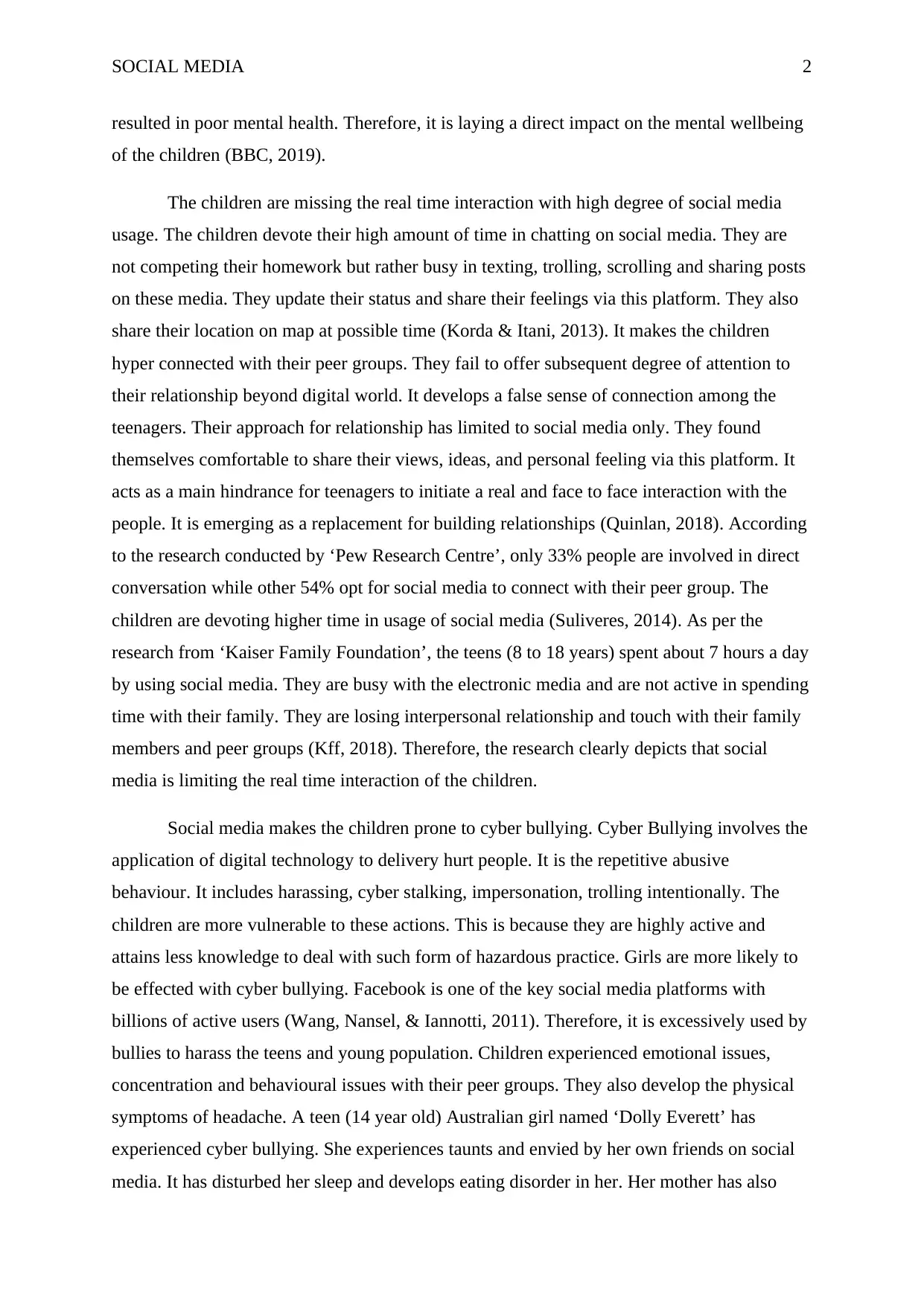
SOCIAL MEDIA 2
resulted in poor mental health. Therefore, it is laying a direct impact on the mental wellbeing
of the children (BBC, 2019).
The children are missing the real time interaction with high degree of social media
usage. The children devote their high amount of time in chatting on social media. They are
not competing their homework but rather busy in texting, trolling, scrolling and sharing posts
on these media. They update their status and share their feelings via this platform. They also
share their location on map at possible time (Korda & Itani, 2013). It makes the children
hyper connected with their peer groups. They fail to offer subsequent degree of attention to
their relationship beyond digital world. It develops a false sense of connection among the
teenagers. Their approach for relationship has limited to social media only. They found
themselves comfortable to share their views, ideas, and personal feeling via this platform. It
acts as a main hindrance for teenagers to initiate a real and face to face interaction with the
people. It is emerging as a replacement for building relationships (Quinlan, 2018). According
to the research conducted by ‘Pew Research Centre’, only 33% people are involved in direct
conversation while other 54% opt for social media to connect with their peer group. The
children are devoting higher time in usage of social media (Suliveres, 2014). As per the
research from ‘Kaiser Family Foundation’, the teens (8 to 18 years) spent about 7 hours a day
by using social media. They are busy with the electronic media and are not active in spending
time with their family. They are losing interpersonal relationship and touch with their family
members and peer groups (Kff, 2018). Therefore, the research clearly depicts that social
media is limiting the real time interaction of the children.
Social media makes the children prone to cyber bullying. Cyber Bullying involves the
application of digital technology to delivery hurt people. It is the repetitive abusive
behaviour. It includes harassing, cyber stalking, impersonation, trolling intentionally. The
children are more vulnerable to these actions. This is because they are highly active and
attains less knowledge to deal with such form of hazardous practice. Girls are more likely to
be effected with cyber bullying. Facebook is one of the key social media platforms with
billions of active users (Wang, Nansel, & Iannotti, 2011). Therefore, it is excessively used by
bullies to harass the teens and young population. Children experienced emotional issues,
concentration and behavioural issues with their peer groups. They also develop the physical
symptoms of headache. A teen (14 year old) Australian girl named ‘Dolly Everett’ has
experienced cyber bullying. She experiences taunts and envied by her own friends on social
media. It has disturbed her sleep and develops eating disorder in her. Her mother has also
resulted in poor mental health. Therefore, it is laying a direct impact on the mental wellbeing
of the children (BBC, 2019).
The children are missing the real time interaction with high degree of social media
usage. The children devote their high amount of time in chatting on social media. They are
not competing their homework but rather busy in texting, trolling, scrolling and sharing posts
on these media. They update their status and share their feelings via this platform. They also
share their location on map at possible time (Korda & Itani, 2013). It makes the children
hyper connected with their peer groups. They fail to offer subsequent degree of attention to
their relationship beyond digital world. It develops a false sense of connection among the
teenagers. Their approach for relationship has limited to social media only. They found
themselves comfortable to share their views, ideas, and personal feeling via this platform. It
acts as a main hindrance for teenagers to initiate a real and face to face interaction with the
people. It is emerging as a replacement for building relationships (Quinlan, 2018). According
to the research conducted by ‘Pew Research Centre’, only 33% people are involved in direct
conversation while other 54% opt for social media to connect with their peer group. The
children are devoting higher time in usage of social media (Suliveres, 2014). As per the
research from ‘Kaiser Family Foundation’, the teens (8 to 18 years) spent about 7 hours a day
by using social media. They are busy with the electronic media and are not active in spending
time with their family. They are losing interpersonal relationship and touch with their family
members and peer groups (Kff, 2018). Therefore, the research clearly depicts that social
media is limiting the real time interaction of the children.
Social media makes the children prone to cyber bullying. Cyber Bullying involves the
application of digital technology to delivery hurt people. It is the repetitive abusive
behaviour. It includes harassing, cyber stalking, impersonation, trolling intentionally. The
children are more vulnerable to these actions. This is because they are highly active and
attains less knowledge to deal with such form of hazardous practice. Girls are more likely to
be effected with cyber bullying. Facebook is one of the key social media platforms with
billions of active users (Wang, Nansel, & Iannotti, 2011). Therefore, it is excessively used by
bullies to harass the teens and young population. Children experienced emotional issues,
concentration and behavioural issues with their peer groups. They also develop the physical
symptoms of headache. A teen (14 year old) Australian girl named ‘Dolly Everett’ has
experienced cyber bullying. She experiences taunts and envied by her own friends on social
media. It has disturbed her sleep and develops eating disorder in her. Her mother has also
⊘ This is a preview!⊘
Do you want full access?
Subscribe today to unlock all pages.

Trusted by 1+ million students worldwide
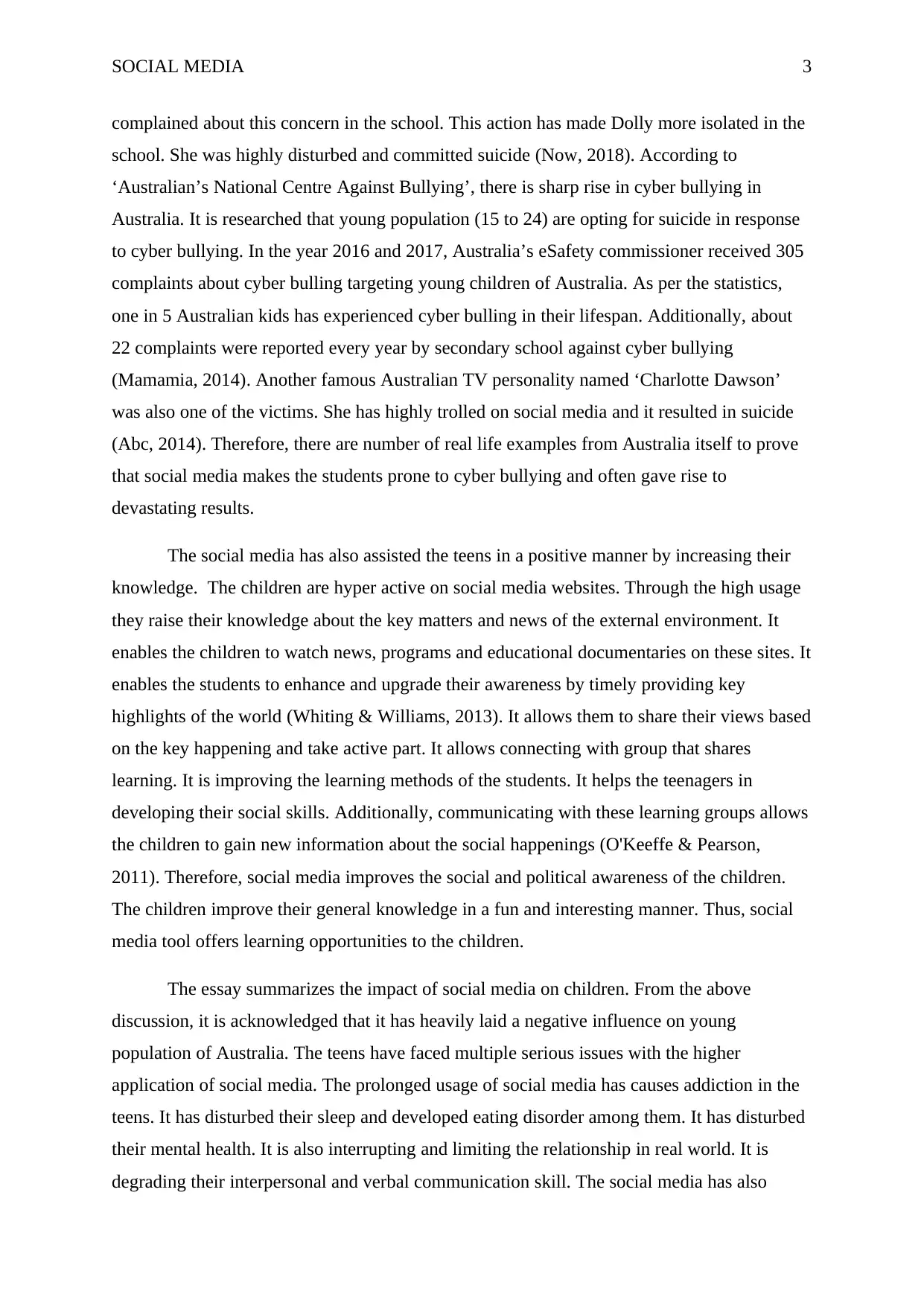
SOCIAL MEDIA 3
complained about this concern in the school. This action has made Dolly more isolated in the
school. She was highly disturbed and committed suicide (Now, 2018). According to
‘Australian’s National Centre Against Bullying’, there is sharp rise in cyber bullying in
Australia. It is researched that young population (15 to 24) are opting for suicide in response
to cyber bullying. In the year 2016 and 2017, Australia’s eSafety commissioner received 305
complaints about cyber bulling targeting young children of Australia. As per the statistics,
one in 5 Australian kids has experienced cyber bulling in their lifespan. Additionally, about
22 complaints were reported every year by secondary school against cyber bullying
(Mamamia, 2014). Another famous Australian TV personality named ‘Charlotte Dawson’
was also one of the victims. She has highly trolled on social media and it resulted in suicide
(Abc, 2014). Therefore, there are number of real life examples from Australia itself to prove
that social media makes the students prone to cyber bullying and often gave rise to
devastating results.
The social media has also assisted the teens in a positive manner by increasing their
knowledge. The children are hyper active on social media websites. Through the high usage
they raise their knowledge about the key matters and news of the external environment. It
enables the children to watch news, programs and educational documentaries on these sites. It
enables the students to enhance and upgrade their awareness by timely providing key
highlights of the world (Whiting & Williams, 2013). It allows them to share their views based
on the key happening and take active part. It allows connecting with group that shares
learning. It is improving the learning methods of the students. It helps the teenagers in
developing their social skills. Additionally, communicating with these learning groups allows
the children to gain new information about the social happenings (O'Keeffe & Pearson,
2011). Therefore, social media improves the social and political awareness of the children.
The children improve their general knowledge in a fun and interesting manner. Thus, social
media tool offers learning opportunities to the children.
The essay summarizes the impact of social media on children. From the above
discussion, it is acknowledged that it has heavily laid a negative influence on young
population of Australia. The teens have faced multiple serious issues with the higher
application of social media. The prolonged usage of social media has causes addiction in the
teens. It has disturbed their sleep and developed eating disorder among them. It has disturbed
their mental health. It is also interrupting and limiting the relationship in real world. It is
degrading their interpersonal and verbal communication skill. The social media has also
complained about this concern in the school. This action has made Dolly more isolated in the
school. She was highly disturbed and committed suicide (Now, 2018). According to
‘Australian’s National Centre Against Bullying’, there is sharp rise in cyber bullying in
Australia. It is researched that young population (15 to 24) are opting for suicide in response
to cyber bullying. In the year 2016 and 2017, Australia’s eSafety commissioner received 305
complaints about cyber bulling targeting young children of Australia. As per the statistics,
one in 5 Australian kids has experienced cyber bulling in their lifespan. Additionally, about
22 complaints were reported every year by secondary school against cyber bullying
(Mamamia, 2014). Another famous Australian TV personality named ‘Charlotte Dawson’
was also one of the victims. She has highly trolled on social media and it resulted in suicide
(Abc, 2014). Therefore, there are number of real life examples from Australia itself to prove
that social media makes the students prone to cyber bullying and often gave rise to
devastating results.
The social media has also assisted the teens in a positive manner by increasing their
knowledge. The children are hyper active on social media websites. Through the high usage
they raise their knowledge about the key matters and news of the external environment. It
enables the children to watch news, programs and educational documentaries on these sites. It
enables the students to enhance and upgrade their awareness by timely providing key
highlights of the world (Whiting & Williams, 2013). It allows them to share their views based
on the key happening and take active part. It allows connecting with group that shares
learning. It is improving the learning methods of the students. It helps the teenagers in
developing their social skills. Additionally, communicating with these learning groups allows
the children to gain new information about the social happenings (O'Keeffe & Pearson,
2011). Therefore, social media improves the social and political awareness of the children.
The children improve their general knowledge in a fun and interesting manner. Thus, social
media tool offers learning opportunities to the children.
The essay summarizes the impact of social media on children. From the above
discussion, it is acknowledged that it has heavily laid a negative influence on young
population of Australia. The teens have faced multiple serious issues with the higher
application of social media. The prolonged usage of social media has causes addiction in the
teens. It has disturbed their sleep and developed eating disorder among them. It has disturbed
their mental health. It is also interrupting and limiting the relationship in real world. It is
degrading their interpersonal and verbal communication skill. The social media has also
Paraphrase This Document
Need a fresh take? Get an instant paraphrase of this document with our AI Paraphraser
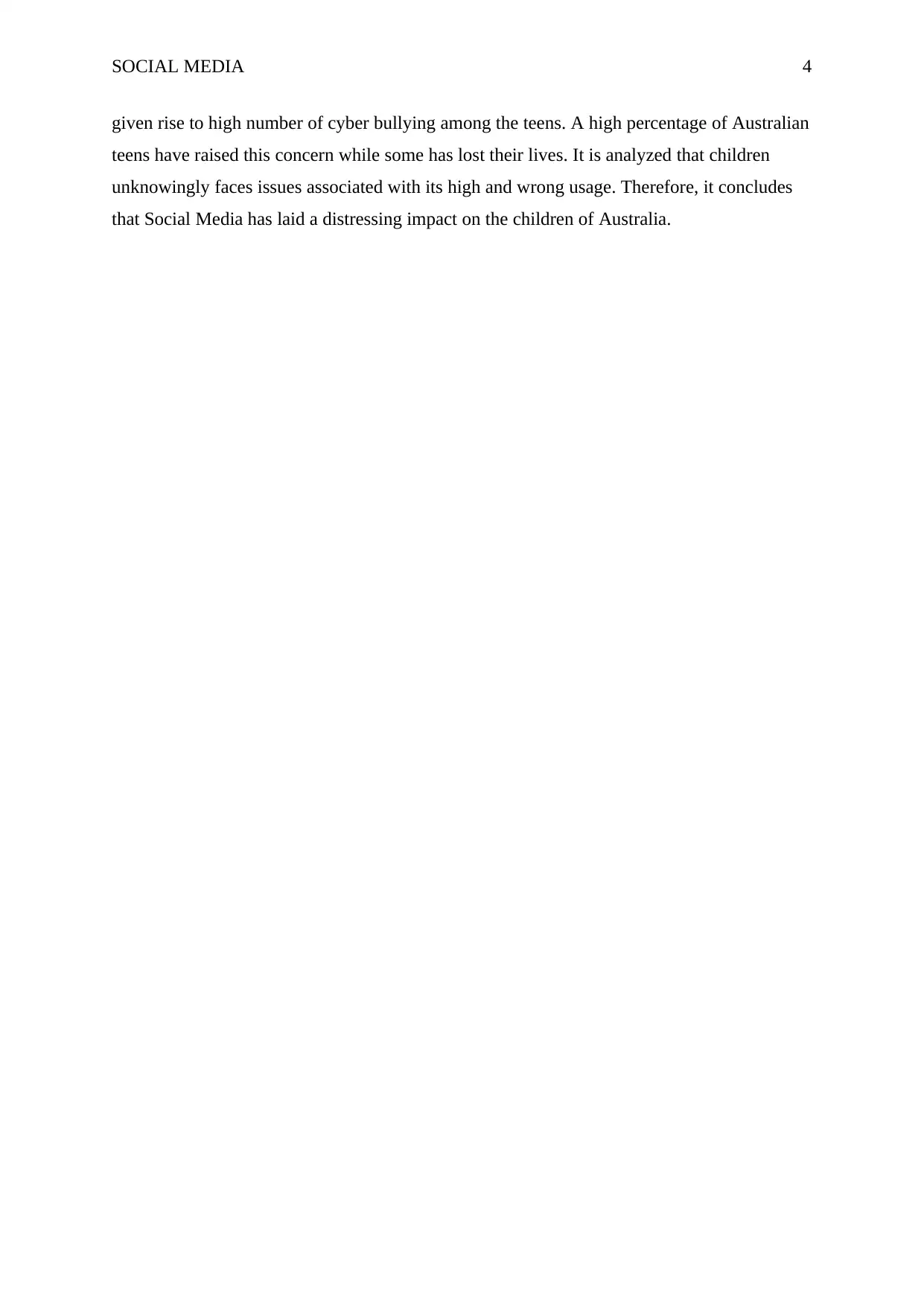
SOCIAL MEDIA 4
given rise to high number of cyber bullying among the teens. A high percentage of Australian
teens have raised this concern while some has lost their lives. It is analyzed that children
unknowingly faces issues associated with its high and wrong usage. Therefore, it concludes
that Social Media has laid a distressing impact on the children of Australia.
given rise to high number of cyber bullying among the teens. A high percentage of Australian
teens have raised this concern while some has lost their lives. It is analyzed that children
unknowingly faces issues associated with its high and wrong usage. Therefore, it concludes
that Social Media has laid a distressing impact on the children of Australia.
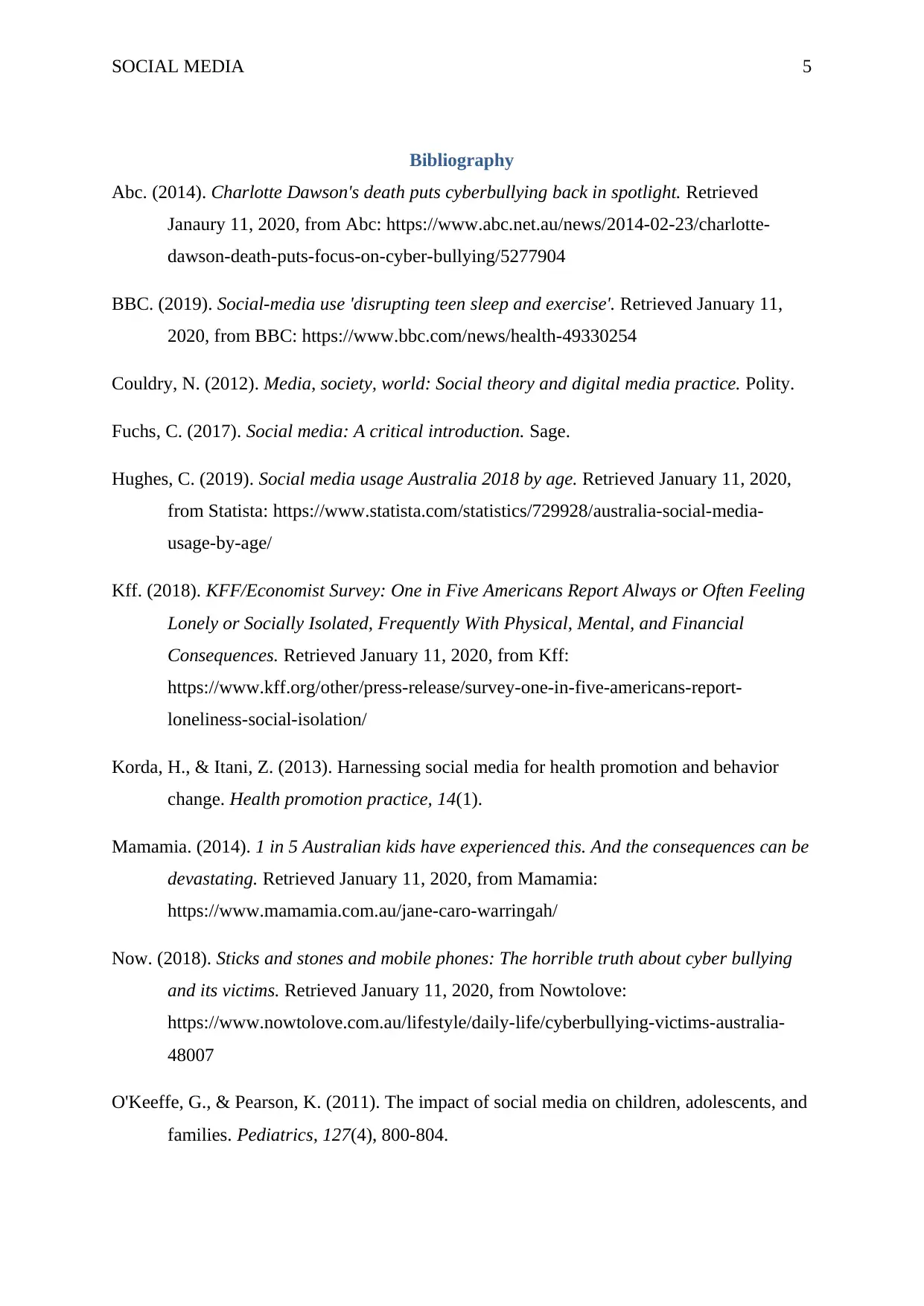
SOCIAL MEDIA 5
Bibliography
Abc. (2014). Charlotte Dawson's death puts cyberbullying back in spotlight. Retrieved
Janaury 11, 2020, from Abc: https://www.abc.net.au/news/2014-02-23/charlotte-
dawson-death-puts-focus-on-cyber-bullying/5277904
BBC. (2019). Social-media use 'disrupting teen sleep and exercise'. Retrieved January 11,
2020, from BBC: https://www.bbc.com/news/health-49330254
Couldry, N. (2012). Media, society, world: Social theory and digital media practice. Polity.
Fuchs, C. (2017). Social media: A critical introduction. Sage.
Hughes, C. (2019). Social media usage Australia 2018 by age. Retrieved January 11, 2020,
from Statista: https://www.statista.com/statistics/729928/australia-social-media-
usage-by-age/
Kff. (2018). KFF/Economist Survey: One in Five Americans Report Always or Often Feeling
Lonely or Socially Isolated, Frequently With Physical, Mental, and Financial
Consequences. Retrieved January 11, 2020, from Kff:
https://www.kff.org/other/press-release/survey-one-in-five-americans-report-
loneliness-social-isolation/
Korda, H., & Itani, Z. (2013). Harnessing social media for health promotion and behavior
change. Health promotion practice, 14(1).
Mamamia. (2014). 1 in 5 Australian kids have experienced this. And the consequences can be
devastating. Retrieved January 11, 2020, from Mamamia:
https://www.mamamia.com.au/jane-caro-warringah/
Now. (2018). Sticks and stones and mobile phones: The horrible truth about cyber bullying
and its victims. Retrieved January 11, 2020, from Nowtolove:
https://www.nowtolove.com.au/lifestyle/daily-life/cyberbullying-victims-australia-
48007
O'Keeffe, G., & Pearson, K. (2011). The impact of social media on children, adolescents, and
families. Pediatrics, 127(4), 800-804.
Bibliography
Abc. (2014). Charlotte Dawson's death puts cyberbullying back in spotlight. Retrieved
Janaury 11, 2020, from Abc: https://www.abc.net.au/news/2014-02-23/charlotte-
dawson-death-puts-focus-on-cyber-bullying/5277904
BBC. (2019). Social-media use 'disrupting teen sleep and exercise'. Retrieved January 11,
2020, from BBC: https://www.bbc.com/news/health-49330254
Couldry, N. (2012). Media, society, world: Social theory and digital media practice. Polity.
Fuchs, C. (2017). Social media: A critical introduction. Sage.
Hughes, C. (2019). Social media usage Australia 2018 by age. Retrieved January 11, 2020,
from Statista: https://www.statista.com/statistics/729928/australia-social-media-
usage-by-age/
Kff. (2018). KFF/Economist Survey: One in Five Americans Report Always or Often Feeling
Lonely or Socially Isolated, Frequently With Physical, Mental, and Financial
Consequences. Retrieved January 11, 2020, from Kff:
https://www.kff.org/other/press-release/survey-one-in-five-americans-report-
loneliness-social-isolation/
Korda, H., & Itani, Z. (2013). Harnessing social media for health promotion and behavior
change. Health promotion practice, 14(1).
Mamamia. (2014). 1 in 5 Australian kids have experienced this. And the consequences can be
devastating. Retrieved January 11, 2020, from Mamamia:
https://www.mamamia.com.au/jane-caro-warringah/
Now. (2018). Sticks and stones and mobile phones: The horrible truth about cyber bullying
and its victims. Retrieved January 11, 2020, from Nowtolove:
https://www.nowtolove.com.au/lifestyle/daily-life/cyberbullying-victims-australia-
48007
O'Keeffe, G., & Pearson, K. (2011). The impact of social media on children, adolescents, and
families. Pediatrics, 127(4), 800-804.
⊘ This is a preview!⊘
Do you want full access?
Subscribe today to unlock all pages.

Trusted by 1+ million students worldwide
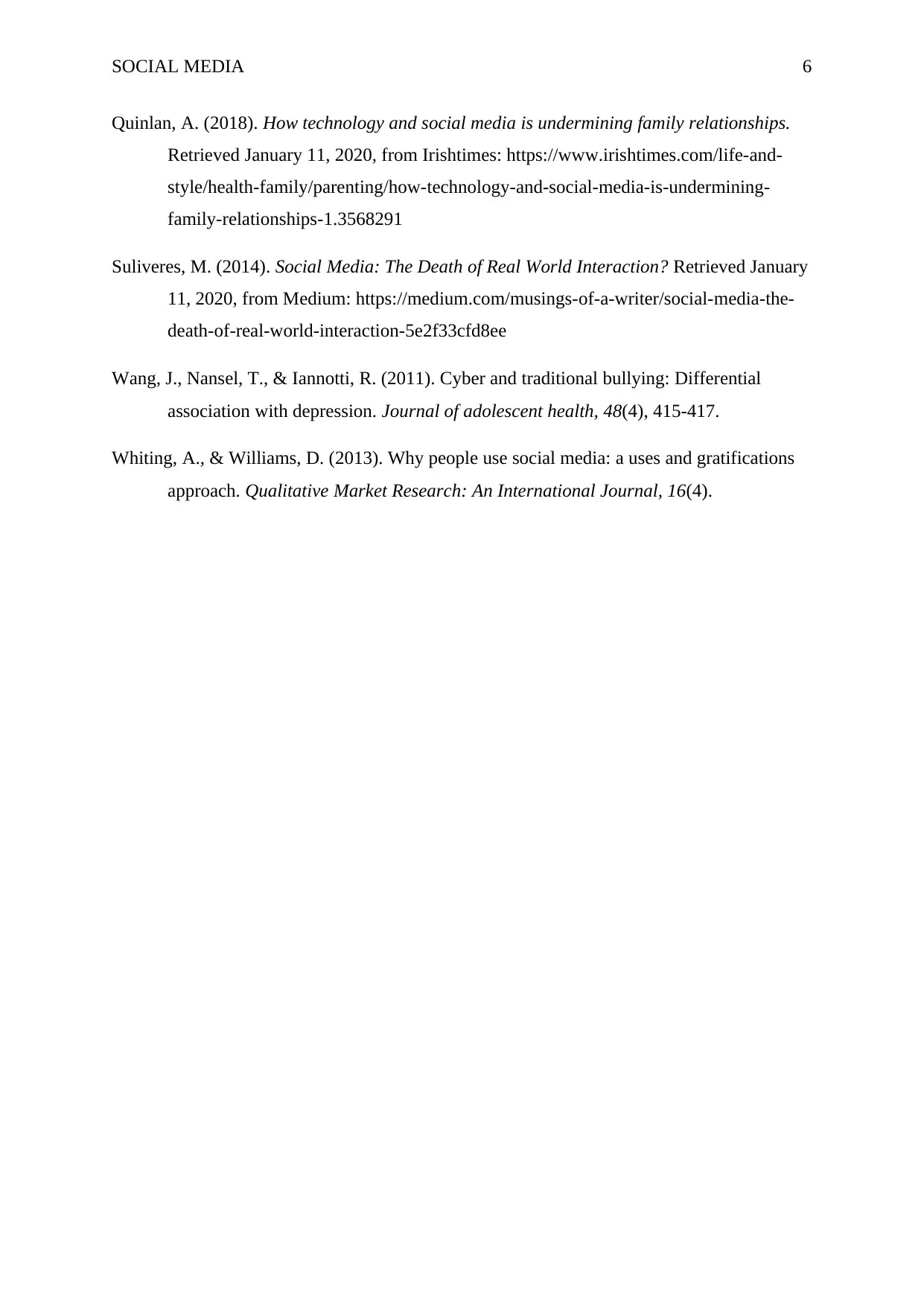
SOCIAL MEDIA 6
Quinlan, A. (2018). How technology and social media is undermining family relationships.
Retrieved January 11, 2020, from Irishtimes: https://www.irishtimes.com/life-and-
style/health-family/parenting/how-technology-and-social-media-is-undermining-
family-relationships-1.3568291
Suliveres, M. (2014). Social Media: The Death of Real World Interaction? Retrieved January
11, 2020, from Medium: https://medium.com/musings-of-a-writer/social-media-the-
death-of-real-world-interaction-5e2f33cfd8ee
Wang, J., Nansel, T., & Iannotti, R. (2011). Cyber and traditional bullying: Differential
association with depression. Journal of adolescent health, 48(4), 415-417.
Whiting, A., & Williams, D. (2013). Why people use social media: a uses and gratifications
approach. Qualitative Market Research: An International Journal, 16(4).
Quinlan, A. (2018). How technology and social media is undermining family relationships.
Retrieved January 11, 2020, from Irishtimes: https://www.irishtimes.com/life-and-
style/health-family/parenting/how-technology-and-social-media-is-undermining-
family-relationships-1.3568291
Suliveres, M. (2014). Social Media: The Death of Real World Interaction? Retrieved January
11, 2020, from Medium: https://medium.com/musings-of-a-writer/social-media-the-
death-of-real-world-interaction-5e2f33cfd8ee
Wang, J., Nansel, T., & Iannotti, R. (2011). Cyber and traditional bullying: Differential
association with depression. Journal of adolescent health, 48(4), 415-417.
Whiting, A., & Williams, D. (2013). Why people use social media: a uses and gratifications
approach. Qualitative Market Research: An International Journal, 16(4).
1 out of 7
Related Documents
Your All-in-One AI-Powered Toolkit for Academic Success.
+13062052269
info@desklib.com
Available 24*7 on WhatsApp / Email
![[object Object]](/_next/static/media/star-bottom.7253800d.svg)
Unlock your academic potential
Copyright © 2020–2025 A2Z Services. All Rights Reserved. Developed and managed by ZUCOL.




